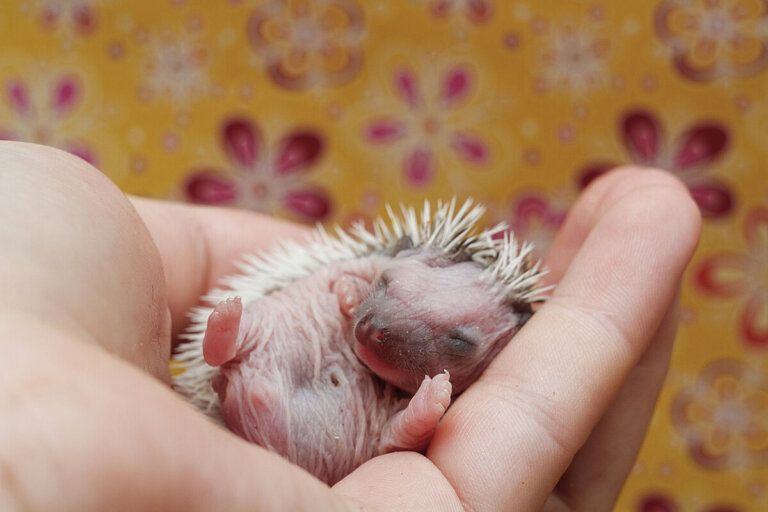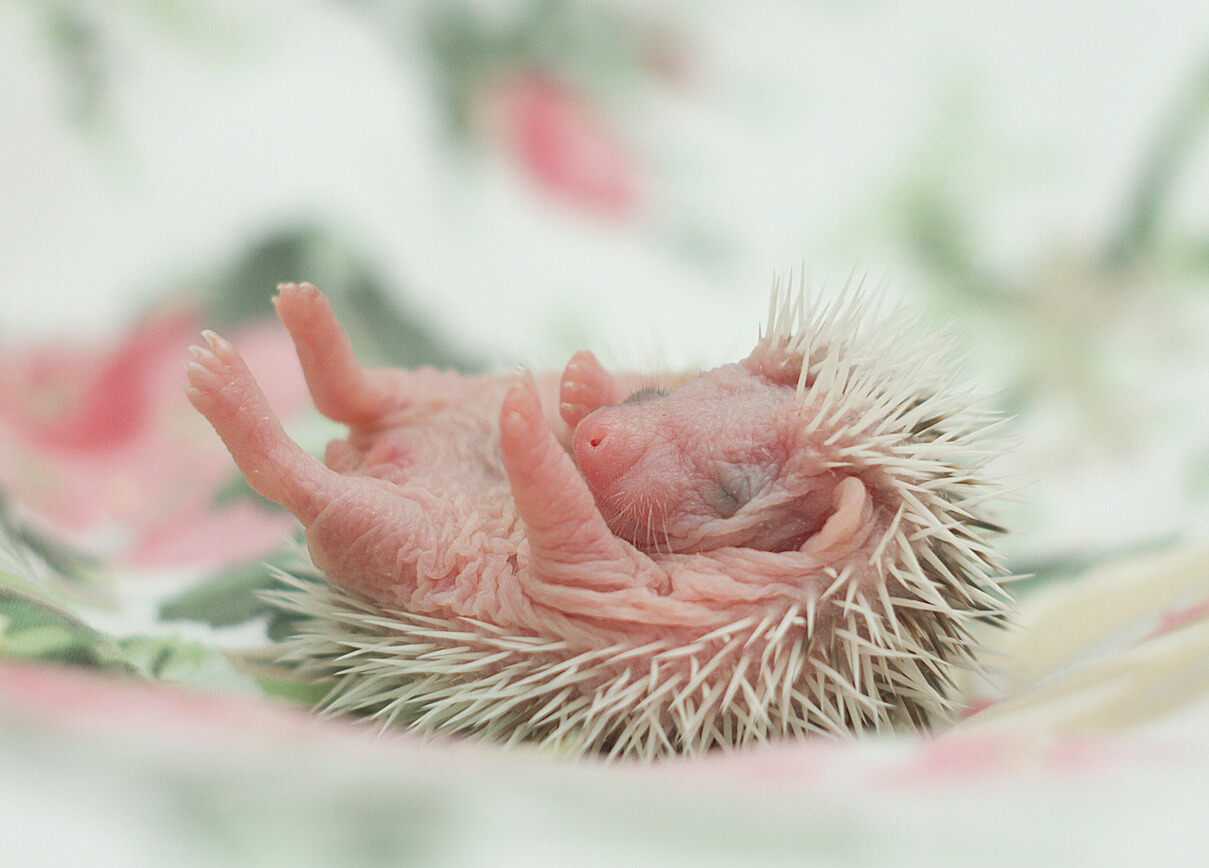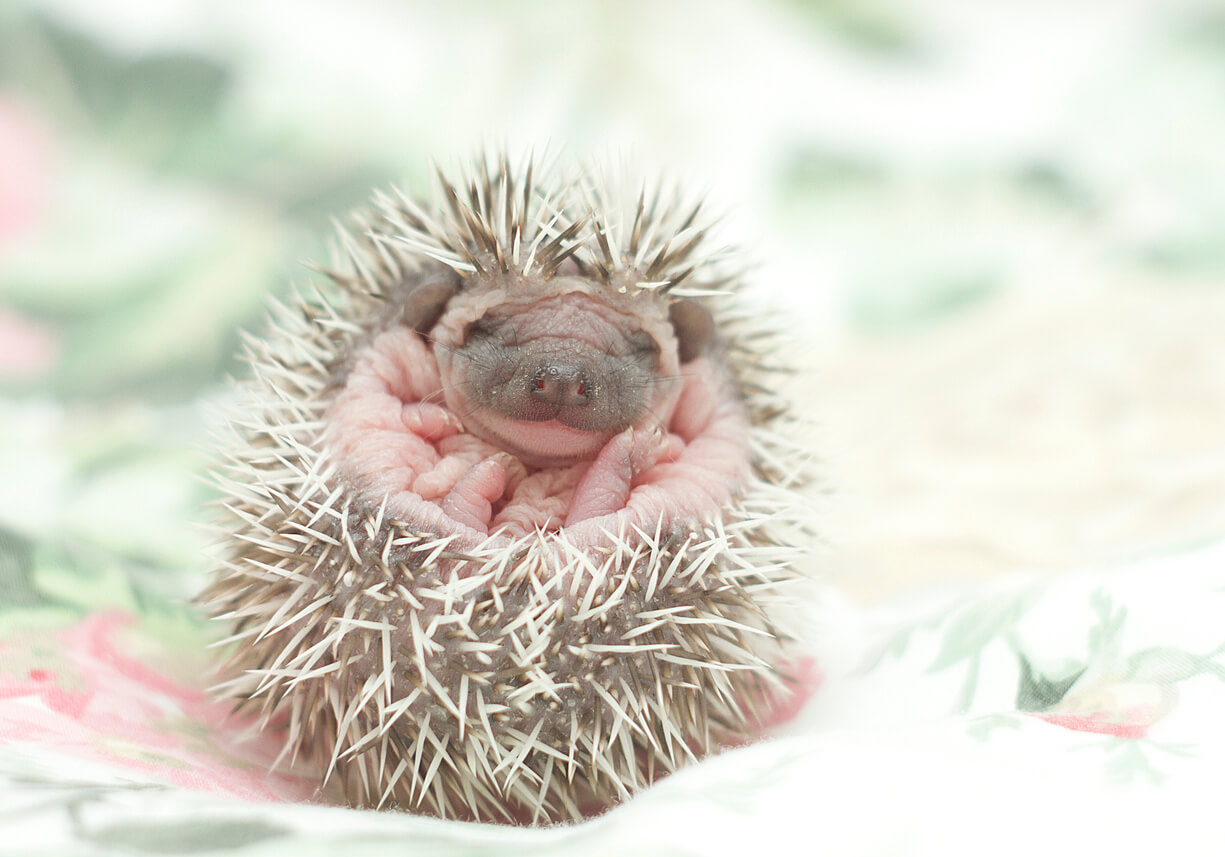Your Baby Hedgehog: All the Care You Need to Take into Account

Hedgehogs are adorable little animals that come into the world blind. Therefore, a baby hedgehog faces multiple challenges for survival, including the risk of injury and death caused by its mother. To minimize the possibility of rejection, it’s best to provide privacy to the female and her young during the seven days before birth and the first ten days after birth.
Although you should give them their space, when it comes to caring for baby hedgehogs, it’s important to monitor that everything’s going well. In other words, verify that the newborns are making sounds and that the mother is feeding them so that nursing is optimal.
If you have some hedgehogs at home that are only a few days old -whether they’re under their mother’s care or in her absence- this article is for you. In the following lines, you’ll discover the characteristics of these little ones as well as the main attention they require in their first weeks of life.
Taxonomy and natural habitat
There are about 17 species of hedgehogs, distributed in five genera, and their taxonomic classification places them in the family Erinaceidae, a group of insectivores of diverse appearance and small size.
Hedgehogs are wild, solitary, and nocturnal animals found in Europe, Africa, and Asia. This small mammal – covered with quills on most of its body – isn’t a common companion animal. Today, however, many people keep hedgehogs as pets.
What does a baby hedgehog look like when it’s born?

Experts at the AAP Foundation point out that baby hedgehogs have very particular characteristics. Knowing them will allow you to better manage these pets in the early stages of their life. These fragile little ones are known as altricial. They come into the world with an average weight of 10 grams. They’re gray in color, except for their faces and bellies, which are pink.
As far as their senses are concerned, baby hedgehogs are blind at birth. They begin to open their eyes at two weeks of age. By then, they can curl up into a ball. Their characteristic quills aren’t visible when they’re newborns. They wait under the skin, protected by a layer of liquid. They begin to appear 24 hours after birth, when the liquid is absorbed, allowing them to come to the surface. These pioneer spines are white. Later, at 36 hours of age, brown spines emerge among the white ones.
By the time a baby hedgehog is two weeks old, the white quills are hardly visible.
What care do altricial hedgehogs require?
If you have a female hedgehog that has reached sexual maturity and you notice that she has gained more than 50% of her weight – after being close to a male – be prepared to receive a litter of altricial, consisting of four to five offspring, on average. Gestation lasts between 34 and 37 days. During this period and during lactation, their nutritional requirements increase.
In the first weeks, baby hedgehogs should stay with their mother so that they can feed and receive maternal immunity. It’s a good idea to touch the altricial hedgehogs because their mother may reject them.
The MSD Veterinary Manual states that the female should be guaranteed “strict privacy from other hedgehogs and humans from one week before birth and for one to two weeks after birth”. In this way, the risk of infanticide and cannibalism of the young is reduced. For this reason, only after ten days of life can the altricial be handled.
Although you need to give the mother and her offspring their space, you should be sure that the little ones make sounds. Monitoring is necessary because the parents may eat or, as mentioned above, reject their offspring. If the second situation occurs, the offspring should be raised by another mother -if she accepts them- or by humans.
When it’s time to nurse, the little ones must compete for their turn. If they don’t succeed, they put their lives at risk because they can die of malnutrition.
The weaning process takes place between 4 and 6 weeks of life. When it occurs, the little ones should be provided with other foods. In this case, you can offer them wet cat food, just like its dry variant, but hydrated with water. Also, by week eight, the baby hedgehogs can be moved to separate cages, according to the aforementioned MSD Veterinary Manual.
How to care for a baby hedgehog without its mother?

If a mother refuses her young, the babies may be removed from the care area and not nursed. If you’re faced with this situation, try to bring the young back together with their mother without touching them so that they don’t take on your scent.
If this action is unsuccessful, you can try to place the altricial with another mother who has a litter. If this isn’t a possibility, you should take charge. Remember that a baby hedgehog needs to eat every 2 to 4 hours, in the first two weeks. After that, it can be fed every 4 hours.
According to Veterinary Clinics of North America: Exotic Animal Practice, when supplemental feeding is necessary, you can offer goat’s milk or Esbilac (powdered milk substitute for pots) to the little ones.
To administer the milk, it should be lukewarm. In addition, it’s a good idea to use a syringe without a needle or a special bottle for small animals.
After feeding, you should stimulate urination and bowel movements in the young. To do this, use a small wet washcloth and rub the groin area.
Newborns need to be in a warm place. You can place them in a small cardboard box and line it with a towel. In it, place a hot water bottle, wrapped in a towel at the bottom, to keep them warm. It should be changed after a few hours to maintain the temperature.
According to the Caring for Hoglets manual published by the British Hedgehog Preservation Society, it’s important to weigh and measure the altricial every day. To avoid confusing them, this organization recommends marking their quills with nail polish. If the record shows that they haven’t gained weight, adjustments can be made to their food rations. The following ranges can serve as a guide:
- Up to 2 weeks of age: They weigh between 30 and 85 grams. They’re fed, as indicated above, every 2-4 hours or on demand.
- 3 to 4 weeks: They reach between 110 and 170 grams. Feeding is given every 4 hours, and small amounts of protein can be added.
- 5 to 6 weeks: Each baby hedgehog should weigh between 200 and 260 grams. From week six onwards, milk replacer can be eliminated. In addition, at this stage, their nocturnal habits begin to become evident, and this will make them demand food at night.
- 8 weeks: They reach 500 to 600 grams.
How to bathe them?
If the mother is absent to lick them, it’s up to you to keep them clean. To do this, after feeding, moisten a cotton ball in warm water or a drop of baby oil (it can even be olive oil), according to the recommendations of the British Hedgehog Preservation Society. This process won’t only keep them clean, but it also allows them to keep their skin moist.
Baby hedgehog care: Attention and dedication
Caring for a baby hedgehog requires great dedication. Not only must you provide care to the altricial, but also to the mother in order to ensure that gestation and lactation take place in a calm, warm, and stress-free environment. In this way, we seek to avoid the risk of eating or rejecting the little ones.
If you have any doubts, it’s important to contact a veterinarian who specializes in exotic pets, who will be able to guide you in the demanding and rewarding task of raising newborn hedgehogs.
Hedgehogs are adorable little animals that come into the world blind. Therefore, a baby hedgehog faces multiple challenges for survival, including the risk of injury and death caused by its mother. To minimize the possibility of rejection, it’s best to provide privacy to the female and her young during the seven days before birth and the first ten days after birth.
Although you should give them their space, when it comes to caring for baby hedgehogs, it’s important to monitor that everything’s going well. In other words, verify that the newborns are making sounds and that the mother is feeding them so that nursing is optimal.
If you have some hedgehogs at home that are only a few days old -whether they’re under their mother’s care or in her absence- this article is for you. In the following lines, you’ll discover the characteristics of these little ones as well as the main attention they require in their first weeks of life.
Taxonomy and natural habitat
There are about 17 species of hedgehogs, distributed in five genera, and their taxonomic classification places them in the family Erinaceidae, a group of insectivores of diverse appearance and small size.
Hedgehogs are wild, solitary, and nocturnal animals found in Europe, Africa, and Asia. This small mammal – covered with quills on most of its body – isn’t a common companion animal. Today, however, many people keep hedgehogs as pets.
What does a baby hedgehog look like when it’s born?

Experts at the AAP Foundation point out that baby hedgehogs have very particular characteristics. Knowing them will allow you to better manage these pets in the early stages of their life. These fragile little ones are known as altricial. They come into the world with an average weight of 10 grams. They’re gray in color, except for their faces and bellies, which are pink.
As far as their senses are concerned, baby hedgehogs are blind at birth. They begin to open their eyes at two weeks of age. By then, they can curl up into a ball. Their characteristic quills aren’t visible when they’re newborns. They wait under the skin, protected by a layer of liquid. They begin to appear 24 hours after birth, when the liquid is absorbed, allowing them to come to the surface. These pioneer spines are white. Later, at 36 hours of age, brown spines emerge among the white ones.
By the time a baby hedgehog is two weeks old, the white quills are hardly visible.
What care do altricial hedgehogs require?
If you have a female hedgehog that has reached sexual maturity and you notice that she has gained more than 50% of her weight – after being close to a male – be prepared to receive a litter of altricial, consisting of four to five offspring, on average. Gestation lasts between 34 and 37 days. During this period and during lactation, their nutritional requirements increase.
In the first weeks, baby hedgehogs should stay with their mother so that they can feed and receive maternal immunity. It’s a good idea to touch the altricial hedgehogs because their mother may reject them.
The MSD Veterinary Manual states that the female should be guaranteed “strict privacy from other hedgehogs and humans from one week before birth and for one to two weeks after birth”. In this way, the risk of infanticide and cannibalism of the young is reduced. For this reason, only after ten days of life can the altricial be handled.
Although you need to give the mother and her offspring their space, you should be sure that the little ones make sounds. Monitoring is necessary because the parents may eat or, as mentioned above, reject their offspring. If the second situation occurs, the offspring should be raised by another mother -if she accepts them- or by humans.
When it’s time to nurse, the little ones must compete for their turn. If they don’t succeed, they put their lives at risk because they can die of malnutrition.
The weaning process takes place between 4 and 6 weeks of life. When it occurs, the little ones should be provided with other foods. In this case, you can offer them wet cat food, just like its dry variant, but hydrated with water. Also, by week eight, the baby hedgehogs can be moved to separate cages, according to the aforementioned MSD Veterinary Manual.
How to care for a baby hedgehog without its mother?

If a mother refuses her young, the babies may be removed from the care area and not nursed. If you’re faced with this situation, try to bring the young back together with their mother without touching them so that they don’t take on your scent.
If this action is unsuccessful, you can try to place the altricial with another mother who has a litter. If this isn’t a possibility, you should take charge. Remember that a baby hedgehog needs to eat every 2 to 4 hours, in the first two weeks. After that, it can be fed every 4 hours.
According to Veterinary Clinics of North America: Exotic Animal Practice, when supplemental feeding is necessary, you can offer goat’s milk or Esbilac (powdered milk substitute for pots) to the little ones.
To administer the milk, it should be lukewarm. In addition, it’s a good idea to use a syringe without a needle or a special bottle for small animals.
After feeding, you should stimulate urination and bowel movements in the young. To do this, use a small wet washcloth and rub the groin area.
Newborns need to be in a warm place. You can place them in a small cardboard box and line it with a towel. In it, place a hot water bottle, wrapped in a towel at the bottom, to keep them warm. It should be changed after a few hours to maintain the temperature.
According to the Caring for Hoglets manual published by the British Hedgehog Preservation Society, it’s important to weigh and measure the altricial every day. To avoid confusing them, this organization recommends marking their quills with nail polish. If the record shows that they haven’t gained weight, adjustments can be made to their food rations. The following ranges can serve as a guide:
- Up to 2 weeks of age: They weigh between 30 and 85 grams. They’re fed, as indicated above, every 2-4 hours or on demand.
- 3 to 4 weeks: They reach between 110 and 170 grams. Feeding is given every 4 hours, and small amounts of protein can be added.
- 5 to 6 weeks: Each baby hedgehog should weigh between 200 and 260 grams. From week six onwards, milk replacer can be eliminated. In addition, at this stage, their nocturnal habits begin to become evident, and this will make them demand food at night.
- 8 weeks: They reach 500 to 600 grams.
How to bathe them?
If the mother is absent to lick them, it’s up to you to keep them clean. To do this, after feeding, moisten a cotton ball in warm water or a drop of baby oil (it can even be olive oil), according to the recommendations of the British Hedgehog Preservation Society. This process won’t only keep them clean, but it also allows them to keep their skin moist.
Baby hedgehog care: Attention and dedication
Caring for a baby hedgehog requires great dedication. Not only must you provide care to the altricial, but also to the mother in order to ensure that gestation and lactation take place in a calm, warm, and stress-free environment. In this way, we seek to avoid the risk of eating or rejecting the little ones.
If you have any doubts, it’s important to contact a veterinarian who specializes in exotic pets, who will be able to guide you in the demanding and rewarding task of raising newborn hedgehogs.
All cited sources were thoroughly reviewed by our team to ensure their quality, reliability, currency, and validity. The bibliography of this article was considered reliable and of academic or scientific accuracy.
- Asociación EriSOS. ¿Has encontrado un erizo? Consultado el 08 de agosto 2023. http://www.erisos.org/nuestrosproyectos/he-encontrado-un-erizo/
- Bruskin, E. (2019, 13 de junio). How to take care of a newborn babay hedgehog. Hedgehog World. Consultado el 10 de agosto de 2023. https://www.hedgehogworld.com/baby-hedgehog-care/
- British Hedgehog Preservation Society. (s.f.). Caring for hoglets. Consultado el 10 de agosto de 2023. https://www.britishhedgehogs.org.uk/leaflets/L1-Caring-for-Hoglets.pdf
- Clínica Veterinaria Exovet. (2019, 29 de marzo). Guía del Erizo Africano (Atelerix albiventris). Clínica veterinaria de animales exóticos. Consultado el 08 de agosto 2023. https://www.cvexovet.es/2019/03/29/erizo-africano/
- Dierenfeld, E. S. (2009). Feeding behavior and nutrition of the african pygmy hedgehog (Atelerix albiventris). Veterinary Clinics of North America: Exotic Animal Practice, 12(2), 335-337. https://www.sciencedirect.com/science/article/abs/pii/S1094919409000073
- Doss, G. Carpenter, J. (2022, octubre). Management of Hedgehogs. MSD Veterinary Manual. Consultado el 10 de agosto de 2023. https://www.msdvetmanual.com/exotic-and-laboratory-animals/hedgehogs/management-of-hedgehogs
- Fundación AAP. (s.f.). El erizo como mascota. Lo que debes saber antes de comprar un erizo. Consultado el 08 de agosto 2023. https://es.aap.eu/mascotismo-de-exoticos/erizo/
- ITIS (Integrated Taxonomic Information System – Report). (s.f.). Atelerix albiventris. Consultado el 08 de agosto 2023. https://www.itis.gov/servlet/SingleRpt/SingleRpt?search_topic=TSN&search_value=633445#null
- Smith, A. J. (1999). Husbandry and nutrition of hedgehogs. Veterinary Clinics of North America: Exotic Animal Practice, 2(1), 127-141. https://www.sciencedirect.com/science/article/abs/pii/S1094919417301433
This text is provided for informational purposes only and does not replace consultation with a professional. If in doubt, consult your specialist.








